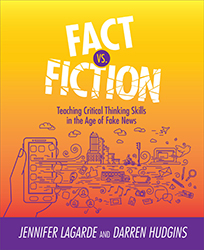Page Content

Detecting false information online is an important part of teaching in the digital age
WITH THE ADVENT OF BLOGS, YouTube and other social media, citizen journalism, entertainment and access to information has exploded. Without doubt, the internet and social media brought with them unprecedented connectedness, news not filtered by governments, and the ability to expose injustice and exploitation worldwide. It has also resulted in a world where misinformation and deception proliferate. Dr. Phil McRae’s May 2010 article in this magazine warned of the “echo-chamber effect,” and one need look no further than Facebook or Twitter to see the extreme views and how entrenched people are in their own “truths.”
FERRETING OUT FAKE NEWS
In 2017, Newsweek named “fake news” word of the year, and what started with unverified text has expanded with technology to include other forms of media. While “photoshopping” has been used as a verb for some time, the ability to modify and fabricate images has extended to video and audio editing to the point where it is almost impossible to distinguish reality from fabrication.
With the advancement of technology and the surge of false information online, many teachers are left wondering how to empower their students to critically view the information they consume online and to be able to distinguish whether something is “fact or cap” (cap is slang for lie or fiction). Fortunately, there are many excellent resources available to schools that offer practical strategies and free lesson materials educators can use in the classroom.
In 2018, Jennifer Lagarde and Darren Hudgins released the book, Fact vs Fiction: Teaching Critical Thinking Skills in the Age of Fake News, which can be signed out by members from the ATA library. In the book, they remind us that “fake news” is an umbrella term for many different types of misleading information with different purposes, and that knowing the types and the purposes each serves further arms us in detecting and interpreting this information.
For example, a satirical article written in The Beaverton has a different purpose and motivation than an article on pseudo–science or propaganda. For further information, the European Association for Viewers Interest created an excellent infographic that describes different types of misleading news called, “Beyond Fake News — 10 Types of Misleading News.” The infographic can be found at https://eavi.eu/infographic-beyond-fake-news-10-types-of-misleading-news-17-languages/.
MediaSmarts.ca, Canada’s centre for digital and media literacy, has numerous resources and lesson materials available at BreakTheFake.ca, released in 2019. This fantastic site includes lesson materials for teachers of all grade levels, quizzes, tips and resources.
In addition to finding and verifying information, MediaSmarts.ca offers numerous digital literacy lesson materials on its website. Teachers can search, “Use, Understand & Create: A Digital Literacy Framework for Canadian Schools” for more.
 MediaSmarts: Four strategies to tell whether something online is true
MediaSmarts: Four strategies to tell whether something online is true
1 Use fact-checking tools such as Snopes.com to see if the story has been debunked.
2 Find the source of the story by clicking on the link in a social media post to determine the website it originated from.
3 Verify the source by researching it to find out whether it has a good track record or has been questioned by others.
4 Check other trusted sources to see if other news outlets are reporting the same story.
RECOMMENDED RESOURCE

Fact vs Fiction: Teaching Critical Thinking Skills in the Age of Fake News
Jennifer Lagarde and Darren Hudgins
Available through the ATA library.
Did you know...
The Educational Technology Council (ETC) of the Alberta Teachers’ Association supports teachers in using technology to enhance teaching and learning.
The ETC provides its membership with
- service and support through professional development opportunities;
- effective communication through an informative newsletter, listserv and dynamic website; and
- an authoritative voice on behalf of the teaching profession through the advocacy of sound educational policies relating to information and communication technology infusion and emerging technologies.
For more information, visit www.teachers.ab.ca.
